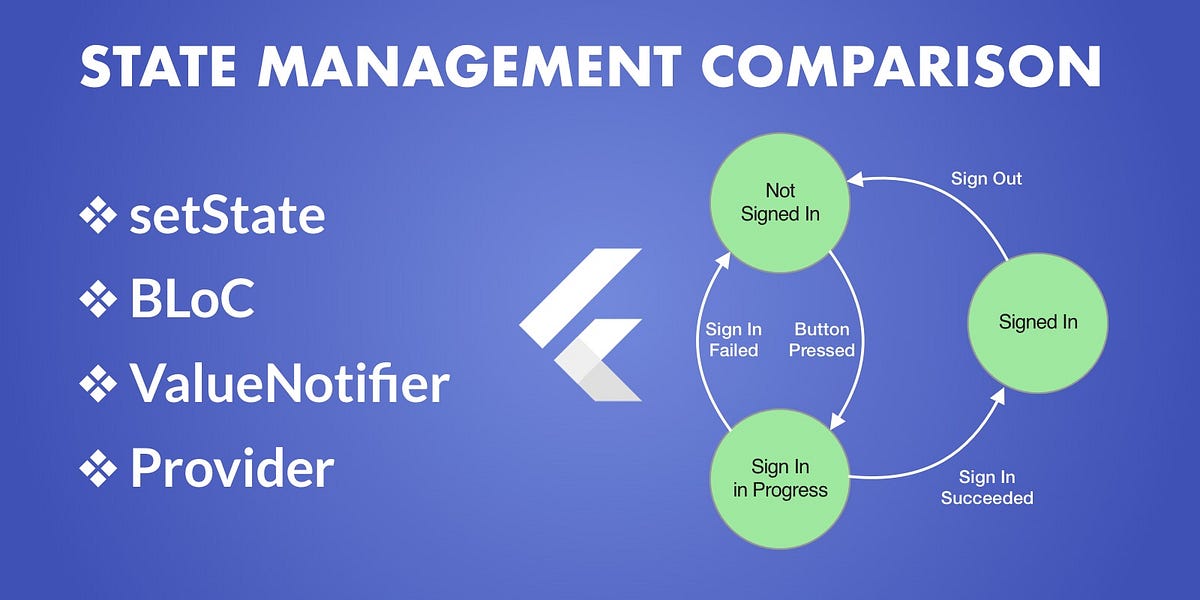Simplifying Flutter State Management: Choosing the Right Approach
 Aaditya Singh
Aaditya Singh
Introduction: State management is a crucial aspect of Flutter app development. As your app grows in complexity, handling and updating the application state becomes essential. Flutter provides various state management approaches, each with its own strengths and use cases. In this blog post, we will explore different state management solutions available in Flutter and help you choose the right approach for your app.
- InheritedWidget and setState(): InheritedWidget and setState() are the simplest forms of state management provided by Flutter. InheritedWidget allows you to propagate the state down the widget tree, making it accessible to its descendants. setState(), on the other hand, is built-in Flutter's StatefulWidget and allows you to update the state of a widget and trigger a rebuild of the UI.
Pros:
Simple and built-in Flutter solutions.
Suitable for small to medium-sized applications with limited state.
Cons:
Can become cumbersome to manage state in large applications with deep widget trees.
Limited scalability and reusability.
- Provider Package: The Provider package is a popular state management solution in Flutter. It builds upon InheritedWidget and offers a more structured and scalable approach. With Provider, you can define separate classes for your application's state, making it easier to manage and access throughout the app.
Pros:
Simplifies state management by providing a scoped approach.
Enables easy access to the state from anywhere in the widget tree.
Supports dependency injection for better code modularity.
Cons:
Might require additional learning and setup compared to basic state management approaches.
Could introduce a performance overhead in large applications.
- BLoC (Business Logic Component) Pattern: BLoC is a powerful design pattern for managing complex states in Flutter apps. It follows a reactive programming approach using streams and stream transformers. BLoC separates the UI layer from the business logic layer, making the code more maintainable and testable.
Pros:
Encourages a clear separation of concerns.
Promotes code reusability and testability.
Scalable for large applications with complex state management requirements.
Cons:
The steeper learning curve, especially for developers new to reactive programming concepts.
Requires additional setup and boilerplate code compared to simpler state management solutions.
- GetX Package: GetX is a lightweight and feature-rich package for state management in Flutter. It provides a reactive approach similar to BLoC but with a simpler syntax and reduced boilerplate. GetX offers features like dependency injection, routing, and localization, making it a comprehensive solution for app development.
Pros:
Simple and intuitive syntax, reducing boilerplate code.
Offers additional features beyond state management.
Excellent performance and efficiency.
Cons:
Smaller community compared to other state management solutions like Provider and BLoC.
Limited official documentation, although community support is growing.
Conclusion: Choosing the right state management approach in Flutter depends on the complexity of your application and your familiarity with reactive programming concepts. While InheritedWidget and setState() are suitable for small apps with simple state requirements, Provider, BLoC, and GetX offer more scalable and structured solutions. Evaluate the needs of your application, consider the learning curve and maintenance overhead, and choose the state management approach that best suits your project. Remember, the right approach can significantly improve the maintainability and scalability of your Flutter application.
Subscribe to my newsletter
Read articles from Aaditya Singh directly inside your inbox. Subscribe to the newsletter, and don't miss out.
Written by
